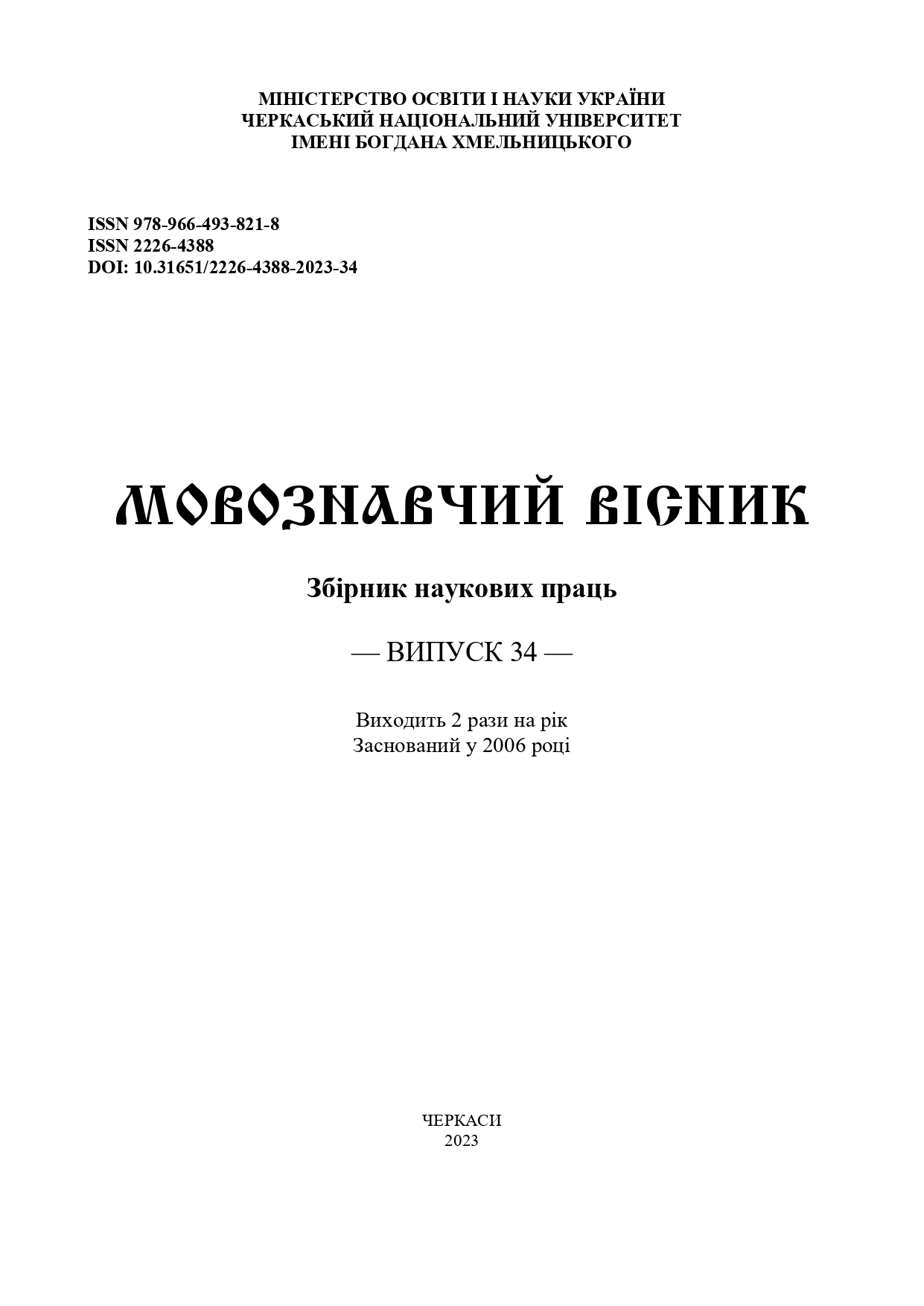METAPHORICAL NEGATION IN MODERN UKRAINIAN AND MONTENEGRIN MEDIA DISCOURSE
Main Article Content
Abstract
Introduction. This article presents the cross-linguistic study of the cognitive and communicative-pragmatic features of the metaphors that convey the negative meaning in modern Ukrainian and Montenegrin media discourse. The relevance of the proposed article is due to the need for deepening ideas about the scope of the category of negation, as well as to determine the cognitive universals of the Slavic languages and to clarify their differences.
The purpose of the article is to compare the conceptual models of metaphors that implement negative content in modern Ukrainian and Montenegrin media discourses, and to find out their communicative and pragmatic load.
The methods. The investigation is grounded on the methods of comparative analysis, conceptual analysis, and contextual analysis.
Main results of the study. Some metaphors function as non-specialized, secondary, but effective expressions of negative content. They enrich media texts with emotional and evaluative nuances, help to obscure negative content or convey it more dramatically.
In both compared languages the main semantic types of negative metaphors are used mainly to describe the failure, hopelessness, inaction or improper functioning of certain institutions, the destruction of something, exposing false information or hiding it. The domain base of negative metaphors includes the names of phenomena, actions, less often – objects associated with some restrictions, damage, immobility and influence on the senses.
Originality. Research prospects are to identify patterns of negative meaning metaphorization in other languages to test their possible universality or variability.
Conclusions and specific suggestions of the author. The Ukrainian and Montenegrin languages are characterized by the same conceptual models of figurative expression of negative content. Minor differences concern only the volume and semantic nuances of metaphorical explicants of negative meaning. We see research perspectives in identifying patterns of metaphorization of negative meaning in other languages to test their possible universality or variability
Article Details
References
Bahan, M. P. (2010). Spetsyfika frazeolohichnoi realizatsii zaperechennia v ukrainskii movi [The
specificity of the phraseological implementation of negation in the Ukrainian language]. In : Movoznavstvo
[Linguistics], 1, 68–75 (in Ukr.).
Bahan, M. P. (2014). Funktsionalna spetsyfika neverbalnykh zasobiv vyrazhennia zaperechennia v
ukrainskomu linhvokulturnomu prostori [Functional specificity of non-verbal means of expressing negation in the
Ukrainian linguistic and cultural space]. In: Slovianskyi zbirnyk [Slavic collection], 18, 195–206 (in Ukr.).
Boeynaems, A., Burgers, C., Konijn, E. A. & Steen, G. J. (2017). The Impact of Conventional and Novel
Metaphors in News on Issue Viewpoint. In, nternational Journal of Communication, 11, 2861–2879 (In Eng.).
Ding, Y. (2011). Implied Negation in Discourse. In: Theory and Practice in Language Studies, 1, 44–51
(in Eng.).
Durán-Escribano, P. & Cuadrado-Esclapez, G. (2017). Constitutive metaphor and mental mappings:
meaning construction in the language of science and technology. In: Revista de Lenguas para Fines Especificos, 23.1,
–107 (in Eng.).
Haegeman, L. (1995). The syntax of negation. Cambridge, ХV, 335 (in Eng.).
Horn, L. R. (2001). A Natural History of Negation. Stanford: CSLI, 637 (in Eng.).
Holovenko, K. V. (2013). Vnutrishnia forma metafory v anhliiskii ta ukrainskii movakh [Internal form of
metaphor in English and Ukrainian languages]. Extended abstract of PhD dissertation (Ukrainian language). Donetsk, 20 (in Ukr.).
Khudoliy, A. (2018). Conceptual metaphors in American journalistic texts. In: Advanced Education, 10,
–184 (in Eng.).
Kӧvecses, Z. (2010). Metaphor and Culture. In: Acta Universitatis Sapientiae, Philologica, 2(2), 197–220
(in Eng.).
Lakoff, G. & Johnson, М. (1980). Metaphors We Live By. Chicago: The University of Chicago Press, 276
(in Eng.).
Levchenko, O. P. (2005). Frazeolohichna symvolika: linhvokulturolohichnyi aspekt [Phraseological
symbolism: linguistic and cultural aspect]. Lviv: LRIDU NADU, 263 (in Ukr.).
Mnatsyan, A. (2017). On the Implicit Negation via Subjunctive Mood. In: English Linguistics Research, 6
(3), 1–4 (in Eng.).
Ozerova, N. G. (1978). Sredstva virazheniya otritsaniya v russkom i ukrainskom yazikakh. Kiev: Naukova
dumka, 214 (in Rus.).
Paslavska, A. Y. (2005). Zaperechennia yak movna universaliia: pryntsypy, parametry funktsionuvannia
[Denial as a linguistic universal: principles, parameters of functioning]. Lviv: Vydavnychyi tsentr LNU im. Ivana
Franka, 290 (in Ukr.).
Penka, D. (2015). Negation and Polarity. In: The Routledge Handbook of Semantics. London, United
Kingdom, 303–319 (in Eng.).
Ruzlcka, M. (1999). Some marginal notes on polarity and negation. In: Sbornik praci filozoficke fakulty
Brnenske Univerzity. Brno studies in English, 25, 43–57 (in Eng.).
Sitdikova, F. B., Eremeyeva, G. R., & Valieva, G. F. (2017). Implicit Negation in Dialogue Discourse. In:
Journal of History Culture and Art Research, 6(6), 175–181 (in Eng.).
Swart, H. (2010). Expression and Interpretation of Negation: An OT Typology. Dordrecht, Holland:
Springer. XVII+279 (in Eng.).

